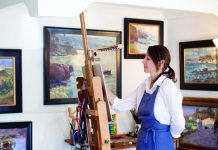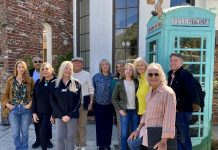
Laguna Beach gallerist Ray Redfern, a collector and dealer of blue-chip California Impressionist and turn-of-the-20th-century California art, described his journey recently in a rare public appearance at the Laguna Outreach for Community Arts’ annual meeting.
For the lucky audience, Redfern drew on his gallery’s elegant repository of works by some of Laguna’s best-known Impressionists, the sort who helped establish the art colony and serve as an inspiration to contemporary plein air painters.
By coincidence, his talk last week preceded the 14th Annual Laguna Beach Plein Air Painting Invitational, underway this week and wrapping up at the Laguna Art Museum on Sunday.
Pulling out museum-quality works by Edgar Payne (founder of what became the Laguna Art Museum) and William Wendt as examples, Redfern described technical and stylistic changes in Wendt’s works over time as his approach noticeably relaxed. The gallerist also presented Brittany fishing boats by Payne and a seascape by Robert Wood, who was nearly as ubiquitous in the 1950s as Robert Kinkade several decades later. He also introduced a painting of poppies by tonalist Granville Redmond as an example of the artist’s bread and butter works, which proved a big hit among Hollywood stars like Charlie Chaplin.
“I started collecting art as a teen-ager, buying my first painting at an estate,” he recalled. His mother, artist Paula Redfern, took him along to classes when he was young. “I believe that helped me greatly in developing an eye for quality art works,” he explained.
In 1976, Redfern and his mother acquired 600 paintings from artist Donna Schuster’s estate (1883-1953), a coup since she was counted among the top female California Impressionist and figurative painters of her time. The same year, he opened his first gallery in Los Angeles, later relocating to Encino. Redfern convinced his art history teacher and the director of the Downey museum to stage a Schuster exhibition, giving the trove invaluable public exposure.
Giving the museum a gift of a 1925 Schuster waterlilies painting provided a bitter-sweet learning experience. “The museum went bankrupt and they sold the painting to one of my competitors in Beverly Hills,” he recalled. “It hurt me immensely and I realized you have to put restrictions on museum gifts,” he said.
In a curious twist, the painting came back up for sale at a Sotheby’s auction and Redfern bought back his own painting. “It’s hanging in my house now, priceless in sentimental value.”
The Schuster paintings got Redfern into the California market, and he acquired his first Edgar Payne for $800. Through connections forged by the Schuster purchase, he also bought several Hansen Puthuff works. It turned out that Puthuff’s children lived in his Los Angeles neighborhood. When Redfern offered them a Schuster portrait of their father, they refused but offered his works for sale instead. Intrigued by Puthuff’s landscapes and strong palette, Redfern agreed and today still sells his works on occasion.
Ironically, the Los Angeles County Museum of Art was selling some of its California Impressionist holdings shortly before interest in early California art resurged. Redfern credited Irvine Museum’s current executive director, Jean Stern, then director at Beverly Hills’ Petersen Gallery, with fueling the revival. Redfern also began buying paintings by Redmond and Jack Smith, he said. “I was at the right place at the right time,” he said.
While he never attended a four-year university, Redfern trusted his instincts and cites Mike Candy, a successful realtor at the time as a mentor, who helped him make major business decisions.
When Redfern’s Encino landlord raised his rent in 1986, he took that as an opportunity to move to Laguna Beach since most California Impressionists at some point lived there and he had wanted to be near the ocean.
When the Montage resort opened in 2002, he established a satellite gallery in the hotel, which he recently closed. Even so, the Payne exhibit in the lobby, offers works from his gallery priced as high as $360,000. His clients have included Joan Irvine Smith, founder of the Irvine Museum, (“She was buying like a crazy person.”) and other collectors whom he, intensely private himself, declines to name.
Redfern established a reputation for locating major works of California Impressionism for museums that include Laguna’s, LACMA and the Oakland Museum of California. He helped underwrite “Edgar Payne: The Scenic Journey,” which recently closed at the Pasadena Museum of California Art and cost roughly $400,000 to stage, he said.
Yet, he too feels the reverberations of a shaky economy and the impact of the Internet. “I used to get offered a lot of paintings but now it’s tougher because everyone can check out values on the Internet. It’s an interesting market,” he said.
His business remains strong on the high end, but slower for mid- and lower-priced works. “People will spend $200,000 but not necessarily $10,000,” he said.
Meanwhile, some works he’s held onto for 30 years, calling them his 401K plan.
Currently, Redfern represent about 15 contemporary plein air artists whose work appears less subtle than that of the old-timers. “In Payne’s time, they had maybe six colors that they had to blend. Today, an artist has a choice of at least 120 colors fresh from the tube,” he said. He advises contemporary artists not to date their work in visible spots. “It’s a psychological deterrent when it looks as if the painting has hung around unsold for too long,” he explains.




